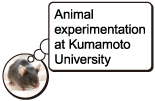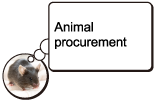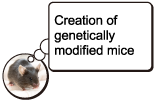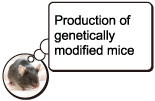Animal care area divisions
The Animal Facility is divided as shown below.Animal care is matched to the isolation level for each area and several limits are set so that pathogenic microorganisms do not spread within the facility.
The area on the right has a high isolation level and strict care is required in regards to use.
In the infectious experiment area, highly infectious pathogenic microorganisms are kept only within the area, thus safe experimentation can be carried out (P2A Level). Within the high-level isolator room, the environment is kept separate for each cage and it is possible to raise germ-free animals.
Conventional area
Requirements
- Areas not monitored for pathogenic microorganisms.
Location
- Main Bldg. some areas of the basement floor
Target animals
- Monkeys, guinea pigs, etc.
SPF area
Requirements
- Most all animal care rooms within the facility are SPF areas.
- SPF (Specific Pathogen Free) refers to a state in which an area is not infected by specific pathogenic microorganisms. See this page for reference regarding specific pathogenic microorganisms that are tested for at Kumamoto University's Animal Facility.
- Animals are raised in an environment with HEPA-filtered air, UV-treated water, and autoclaved bedding and cages, and experimental animals are monitored for pathogenic microbial infection via use of monitor animals.
*Please note that having by having SPF animals living with germ-free animals and immunodeficient animals, infection by pathogenic a microorganism not confirmed in SPF animals can cause death in germ-free or immunodeficient animals.
Location
- New Bldg. 8th, 9th, 10th floor animal care rooms Main Bldg. 2nd, 3rd floor animal care rooms
Target animals
- Mice or rats
Infectious experiment area
Requirements
- Area with dedicated animal care rooms and air system. People, things, animal, and air flow are managed carefully as to not allow infection outside the area.
- P2A diffusion level prevention measures that are necessary in order to perform experiments using genetically modified organisms have been met.
- A special area in which daily animal care management is performed by the researchers themselves.
Location
- Main Bldg. 4th floor
Target animals
- Mice or rats
Isolator room
Requirements
- The plastic isolator is an isolation device that covers up to 4 mouse cages with thick clear plastic and manages isolated mice care with sterile equipment, food, water, and air (HEPA filters used in both intake and exhaust).
- The isolator room, which has several plastic isolators installed, is used mainly for the quarantine of mice and is managed by facility staff. Researchers are not able to use this room directly.
- Sterile animals, gnotobiotic mice, etc. can be raised here.
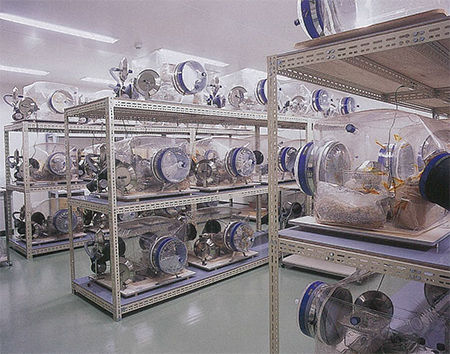
Location
- New Bldg. 7th floor Isolator room Main Bldg. 2nd floor Isolator room
Target animals
- Mice
Area for breeding genetically modified organisms
For areas using diffusion prevention measures (P1A level, P2A level) for handling of genetically modified organisms, see here for reference.NEWS
- New web site is opened.
2016.03.31
SUPPORT
ACTIVITIES
STAFF
Kumamoto University
Institute of Resource Development and Analysis
Center for Animal Resources and Development
〒860-0811
2-2-1 Honjo, Chuo-ku, Kumamoto-shi
TEL :096-373-6550
FAX :096-373-6552
Email :mimura(a)kumamoto-u.ac.jp
Liaison:Imura
Contact List (Internal University use only)
Institute of Resource Development and Analysis
Center for Animal Resources and Development
〒860-0811
2-2-1 Honjo, Chuo-ku, Kumamoto-shi
TEL :096-373-6550
FAX :096-373-6552
Email :mimura(a)kumamoto-u.ac.jp
Liaison:Imura
Contact List (Internal University use only)

